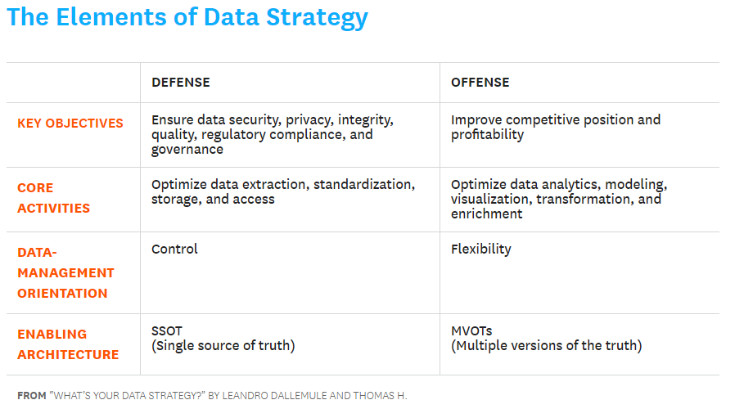
In the upcoming May-June 2017 issue of HBR Review there is an outstanding article authored by Leandro DalleMule, CDO at AIG and Thomas H. Davenport, Professor at Babson College, and MIT Research fellow. It’s already available online here at https://hbr.org/2017/05/whats-your-data-strategy. IMHO it’s highly recommended reading for CDOs or anyone tasked with the monumental task of delivering business value through the best use of data assets across their enterprise.
Kudos to Leandro DalleMule and Thomas H. Davenport for such an excellent piece of work. The following is a brief summary of the article (with copyright attribution to HBR and the authors), with my perspective on how it ties into today’s Modern Data Management platforms.
The article makes a compelling case for a framework for thinking about two forms of data strategy categorized as “defense” and “offense”.
Many organizations have attempted to create highly centralized, control-oriented approaches to data and information architectures. Previously known as information engineering and now as master data management, these top-down approaches are often not well suited to supporting a broad data strategy.
— Source: “What’s your data strategy?” HBR May-June 2017
If you’re familiar with the concept of Master Data Management (often acronymed as MDM), and have been unsuccessfully using legacy MDM tools to aid in your overall data management strategy, the quote above might strike a nerve.
Legacy MDM over the years has been inherently flawed in that the focus on just managing “Master” data through IT governance and practices, not only misses the point of ultimate value to the end business user. The paragraph in the article continues:
Although they are effective for standardizing enterprise data, they can inhibit flexibility, making it harder to customize data or transform it into information that can be applied strategically.
— Source: “What’s your data strategy?” HBR May-June 2017
The perspective of the authors is one which we at Reltio are hearing more and more:
In our experience, a more flexible and realistic approach to data and information architectures involves both a single source of truth (SSOT) and multiple versions of the truth (MVOTs). The SSOT works at the data level; MVOTs support the management of information.
— Source: “What’s your data strategy?” HBR May-June 2017
Companies want a flexible architecture that can do both to have “single and multiple versions of the truth to support a defensive-offensive approach to data strategy.”

Source: “What’s your data strategy?” HBR May-June 2017
What exactly does this mean? SSOT is what you would expect to obtain from a legacy MDM tool if all goes well and everyone agrees and is able to obtain all of the sources that have to be blended together to create such a construct.
The problem with legacy MDM approaches is that it has not been able to keep up with the increasing number of inputs and sources across the enterprise, which ultimately require a continues redesign and rethinking of data models that are tightly coupled with how the data is stored, largely in relational database constructs.
Further legacy MDM has not kept pace with the “big data” labels of volume, velocity and variety of data that needs to be managed and understood by tools which have to be supported by “humans” in the form of data stewards, who continuously have to adjudicate and verify “matches” that are not automatically reconcilable. Additionally a full 360-degree view now is expected to include interactions and transactions, and not just the master data.
Once an SSOT is created, end business users have had a hard time getting personalized relevant insights from this accurate but vast sets of unrelated data. Leaving them having to create their own “versions of the truth” in order to achieve their unique business goals.
Fundamentally as the authors clearly state:
Although the SSOT-MVOTs model is conceptually straightforward, it requires robust data controls, standards, governance, and technology. Ideally, senior executives will actively participate on data governance boards and committees. But data governance isn’t particularly fun. Typically, enterprise CDOs and CTOs lead data and technology governance processes, and business and technology managers in functions and units are the primary participants. What’s critical is that single sources of the truth remain unique and valid, and that multiple versions of the truth diverge from the original source only in carefully controlled ways.
— Source: “What’s your data strategy?” HBR May-June 2017
The article gives excellent examples of companies who have needed to either focus more on defense or offense, and where typically you would lie on the spectrum.
It even offers a set of diagnostic questions you can use to “Assess Your Strategy Position”.
At Reltio we also have a self-assessment tool to start you on the journey to a better SSOT. Click here to see how a contextual assessment for Retail data would look.
The article concludes with these sage words of advice:
Emerging technologies may enable a next generation of data-management capabilities, potentially simplifying the implementation of defensive and offensive strategies. Machine learning, for example, is already facilitating the creation of a single source of truth in many companies we studied. The promise is more-dynamic, less-costly SSOTs and MVOTs. However, no new technology will obviate an effective, well-run data-management function.
— Source: “What’s your data strategy?” HBR May-June 2017
We whole heartedly agree that no one technology can replace the need for a “well-run data management function” but we believe that a Modern Data Management Platform as a Service (PaaS) that was architected from the ground-up to effectively support all of the capabilities discussed in this HBR article is a great foundation for most enterprises.
At Reltio we focus on Reliable Data at scale for “defense” and unlike other legacy MDM platforms, deliver Relevant Insights for “offense” from complete contextual 360-degree views, for personalized engagement, with not just the business users of our customers, but ultimately for their end customers as well.
And just as the authors elude, to machine learning needs to provide the Recommended Actions that not only help with SSOT, but the creation of MVOT to drive business impact.
Please read the excellent HBR article and let me know your thoughts.
